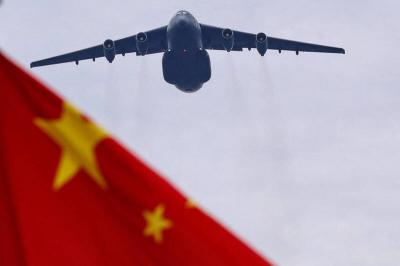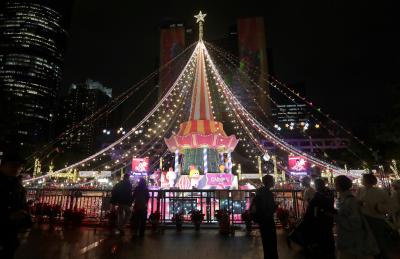The National Center for Research on Earthquake Engineering yesterday called for new laws to encourage the reconstruction of weaker structures, following the partial collapse of four buildings during Tuesday’s earthquake in Hualien.
The magnitude 6 earthquake, which occurred at 11:50pm on Tuesday, 18.3km northeast of Hualien County Hall, had an output level of 7 on the Modified Mercalli Intensity at its strongest point and caused damage to several structures, including two bridges and multiples buildings.
The Marshal Hotel suffered the most damage and was left leaning to one side after its bottom three floors crumpled.

Photo: CNA
At yesterday’s Lunar New Year-end news conference held by the Ministry of Science and Technology, center director-general Huang Shih-chien (黃世建) said the hotel, like structures that collapsed in previous earthquakes, was built before 1999 when stricter building code regulations were introduced.
This, combined with its proximity to the closest fault line, led to its collapse, Huang said.
Often these buildings have large open spaces in their ground floors, making them more prone to collapse, he said.
This is further exacerbated by the occupation of upper floors by residents, he said, adding that pillars or additional walls should be used to provide better structural support.
One of the issues stalling the reinforcement or reconstruction of older buildings is the large number of people who have property rights in the buildings.
Legal regulations governing the reconstruction process should be simplified, he added.
“If a consensus cannot be reached to move forward with reconstruction, I suggest property owners start with incremental, structural reinforcement,” he said, adding that owners of buildings with combined commercial and residential occupation be prohibited from making upper floors of their buildings publicly available until passing earthquake-resilience assessments.
Building Safety Certification Association director-general Tai Yun-fa (戴雲發) said reinforcements would not be enough and that older buildings must be reconstructed.
The Marshal Hotel had already undergone reinforcements, but was still unable to withstand a strong earthquake, he said, adding that the problem lay with its irregular facade and arcade-style architectural design.
Comparing the hotel with the collapse of the Weiguan Jinlong complex in Tainan during the earthquake on Feb. 6, 2016, Tai said that the latter differed in that its layout was not well designed.
The U-shaped design of that building, along with the use of poor-quality building materials, led to its collapse, he said.
Meanwhile, Huang said the center is capable of predicting an earthquake between five and 10 seconds in advance.
High-tech industry operators, including Taiwan Semiconductor Manufacturing Co and United Microelectronics Corp, should network their systems with the center to allow shutdown of equipment in the event of an earthquake, he said, adding this could prevent sensitive systems from damage.
The Taiwan High Speed Rail Corp is already networked with the center, he said.

Beijing could eventually see a full amphibious invasion of Taiwan as the only "prudent" way to bring about unification, the US Department of Defense said in a newly released annual report to Congress. The Pentagon's "Annual Report to Congress: Military and Security Developments Involving the People's Republic of China 2025," was in many ways similar to last year’s report but reorganized the analysis of the options China has to take over Taiwan. Generally, according to the report, Chinese leaders view the People's Liberation Army's (PLA) capabilities for a Taiwan campaign as improving, but they remain uncertain about its readiness to successfully seize

Taiwan is getting a day off on Christmas for the first time in 25 years. The change comes after opposition parties passed a law earlier this year to add or restore five public holidays, including Constitution Day, which falls on today, Dec. 25. The day marks the 1947 adoption of the constitution of the Republic of China, as the government in Taipei is formally known. Back then the Chinese Nationalist Party (KMT) governed China from Nanjing. When the KMT, now an opposition party in Taiwan, passed the legislation on holidays, it said that they would help “commemorate the history of national development.” That

Taiwan has overtaken South Korea this year in per capita income for the first time in 23 years, IMF data showed. Per capita income is a nation’s GDP divided by the total population, used to compare average wealth levels across countries. Taiwan also beat Japan this year on per capita income, after surpassing it for the first time last year, US magazine Newsweek reported yesterday. Across Asia, Taiwan ranked fourth for per capita income at US$37,827 this year due to sustained economic growth, the report said. In the top three spots were Singapore, Macau and Hong Kong, it said. South

Snow fell on Yushan (Jade Mountain, 玉山) yesterday morning as a continental cold air mass sent temperatures below freezing on Taiwan’s tallest peak, the Central Weather Administration (CWA) said. Snowflakes were seen on Yushan’s north peak from 6:28am to 6:38am, but they did not fully cover the ground and no accumulation was recorded, the CWA said. As of 7:42am, the lowest temperature recorded across Taiwan was minus-5.5°C at Yushan’s Fengkou observatory and minus-4.7°C at the Yushan observatory, CWA data showed. On Hehuanshan (合歡山) in Nantou County, a low of 1.3°C was recorded at 6:39pm, when ice pellets fell at Songsyue Lodge (松雪樓), a